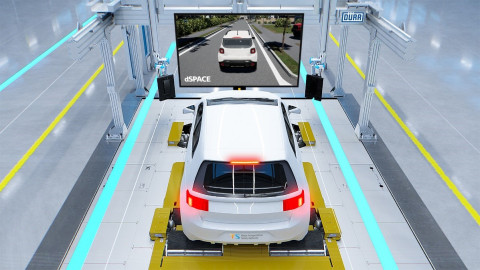한국교통안전공단이 첨단 안전장치 장착 자동차의 운전자 지원 시스템 정기 검사를 위해 독일 기업 dSPACE와 Dürr(듀어)의 혁신 기술을 적용한다고 27일 밝혔다.
 김천·경북 사업 지원 나서…2026년까지 50억원 규모 지방 예산 투입
김천·경북 사업 지원 나서…2026년까지 50억원 규모 지방 예산 투입
검사 차량 카메라·레이더 센서에 대한 다양한 기능 테스트 수행 가능
한국교통안전공단이 첨단 안전장치 장착 자동차의 운전자 지원 시스템 정기 검사를 위해 독일 기업 dSPACE와 Dürr(듀어)의 혁신 기술을 적용한다고 27일 밝혔다.
공단은 시뮬레이션 및 검증 전문기업인 dSPACE와 기계 및 장비 제조업체인 Dürr와 협력해 시뮬레이션 환경을 활용한 첨단 안전장치 장착 자동차에 대한 정기 검사 방법과 표준을 개발하고 있다.
김천시와 경상북도는 이 사업 지원을 위해 별도의 행사를 통해 참여 업체 및 기관 간 협력을 위한 양해각서(MOU)를 체결했으며 2026년까지 약 50억원 규모의 지방 예산을 투입할 예정이다.
차량 모니터링 기관들은 이러한 첨단 운전자 지원 시스템의 신뢰성을 보장하기 위한 방안을 활발하게 논의하고 있다.
국제자동차검사위원회(CITA) 컨퍼런스에서 한국교통안전공단은 국내 최초로 개발한 VIL(Vehicle-in-the-Loop) 테스트 방법을 활용해 ADAS 기능 테스트에 성공한 사례에 대해 발표했다.
VIL 테스트 구성은 Dürr가 특허권을 보유한 검사 차량의 가속, 제동 및 조향이 가능한 x-road curve 섀시 동력계와 dSPACE의 레이더 타겟 시뮬레이터(DARTS·dSPACE Automotive Radar Target Simulator), 차량 동역학 모델(ASM·Automotive Simulation Model), 센서 시뮬레이션 시각화 솔루션(AURELION) 그리고 전체 시스템을 운용하는 실시간 시뮬레이션 플랫폼(SCALEXIO)으로 구성된다.
한국교통안전공단은 이러한 구성으로 가상 테스트 환경을 구축할 수 있으며, 특히 검사 차량에 장착된 카메라 및 레이더 센서에 대한 다양한 기능 테스트를 수행할 수 있다.
카메라와 레이더 센서를 활용하는 첨단 안전장치 검사를 위해 다양한 시나리오를 적용할 수 있으며, 위급 상황에서 정상 동작을 확인할 수 있는 시나리오도 추가될 예정이다.
테스트에 통과하기 위해서 검사 차량은 VIL 시뮬레이션에서 주어지는 새로운 상황에 실시간으로 대응해야 하며, 상황에 따라 비상 제동 장치를 동작시켜야 한다.
2026년까지 진행되는 이번 신규 프로젝트를 위해 dSPACE의 시뮬레이션 및 검증 전문가들과 Dürr의 테스트 엔지니어링 전문가들은 한국교통안전공단과 함께 실제 자동차 정기 검사에 활용할 수 있는 시스템 개발을 위해 협업하고 있다.
한국교통안전공단은 또한 기존의 초기 VIL 설정이 한국 전역의 테스트 벤치에 널리 사용될 수 있도록 추가 개발에 착수할 예정이며 국내 검사 규정도 이에 맞춰 개정할 계획이다.
한국교통안전공단은 ADAS 정기 검사 분야에서 선도적인 역할을 하고 있으며, 유럽, 일본 등 다양한 국가에서 이 프로젝트의 개발 결과에 주목하고 있다.
아멧 카라두만(Ahmet Karaduman) dSPACE ADAS VIL 프로젝트 관리자는 “이번 MOU를 통해 전세계의 검사 기관이 신뢰할 수 있는 재현 가능한 테스트 방법을 개발하고자 한다”며 “이 테스트 벤치는 미래의 고도로 자동화된 차량을 테스트하기 위한 확장 가능한 출발점이 될 것”이라고 말했다.
카이 쿤(Kai Künne) Dürr Assembly Products 자율주행 차량 테스트 제품 관리자는 “dSPACE와의 협력을 통해 Dürr는 혁신적인 테스트 벤치를 제공해 자율주행 기능 사용자의 안전성을 높이고, 동시에 미래의 자율주행차에 대한 신뢰도를 높일 것”이라고 밝혔다.
